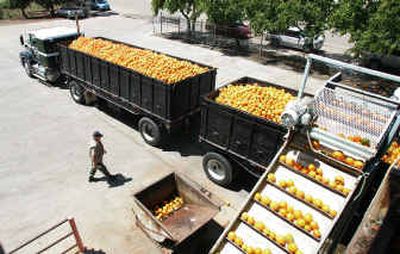Farmers holding the bag

FRESNO, Calif. – The farmers who grow many of the fresh fruits and vegetables for the nation’s dinner tables say the rising cost of oil is making this one of their toughest planting seasons yet – and might shove some of them out of business.
Drivers nationwide have had to pay more as political volatility and increased demand worldwide push up gas prices, said Ron Planting, an economist with the American Petroleum Institute. A barrel of crude oil now sells for as much as $55, up from $35 this time last year.
But farmers are the ones caught in a “three-way whammy,” said Keith Nilmeier, who just finished harvesting his 185 acres of oranges outside Fresno. Farmers are squeezed by higher prices for the diesel that runs their harvesting and irrigation equipment, for the fertilizer made by combining nitrogen with the hydrogen in natural gas, and for the transportation of crops to your local supermarket.
“We’re the bottom link on this whole chain, and we have no one to pass our costs on to,” said Nilmeier. “We just have to take it and try to keep going.”
Farmers nationwide have seen the price of fuel more than double, from 96 cents a gallon in April 2002 to $1.97 in April 2005. In California alone, they use more than 1.5 million gallons of diesel a day at the peak of harvest.
Nationally, U.S. farmers will spend about 10 percent more this year – about $3 billion – on costs including fuel and fertilizer, even as the price consumers pay for fruits and vegetables remains relatively stable, said Terry Francl, senior economist with the American Farm Bureau Federation, a Washington, DC-based group representing farm interests.
“Farmers are price takers, not price makers,” he said. “This means they’ve just had their income reduced by $3 billion.”
The pain of higher fuel prices is being felt throughout the food industry.
Many of the truckers who distribute produce are charging higher prices or getting out of the business, making it harder for farmers to get their crops to wholesalers. Distributors providing fuel directly to small farmers are finding it hard to buy fuel and sell it at a profit in such a volatile market.
Fertilizer manufacturers are also facing much higher domestic natural gas prices, driving the prices they charge higher. The fertilizer’s basic component, anhydrous ammonia, is made by combining natural gas and air at high temperature and pressure. The chemical now sells for about $416 a ton – up from $250 a ton three years ago.
“Fertilizer prices went crazy,” said Craig Ito, who grows peaches, plums, nectarines and other fruit in Fresno County, which has the country’s highest farming grosses.
California has led the nation in agricultural production since World War II. The state’s vast Central Valley – a swath of farmland more than twice the size of Massachusetts – grows most of the world’s almonds, and most U.S.-grown nectarines, walnuts and raisins.
Ito also runs a packing and shipping business that distributes Central Valley fruit. He still ships to places as far away as Taiwan and Japan, but he lost some buyers on the East Coast recently when the price of freight made California fruit too expensive to compete. To keep up with East Coast peaches, he said, he’d have to sell peaches that had sold for $10 to $12 a box for just $8.
“That’s red ink for us,” Ito said.
But diesel prices are climbing so high that many farmers are hard-pressed to find truckers willing to carry their produce, even at a higher price.